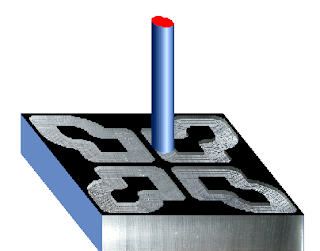Thursday, 28 December 2017
Monday, 18 December 2017
Mirror CNC Program in M Scheme using CNCTRAIN SOFTWARE


M06 T01
M03 S2000
G00 Z5.
G00 X0. Y0.
M98 P1111
M70
M98 P1111
M80
M71
M98 P1111
M81
M70
M71
M98 P1111
M80
M81
M05
M30
O1111
 |
| TOOL DIA 1 MM |
G01 Z-5. F80.
G91
G01 X24. F80.
G01 Y12. F80.
G03 X12 .Y12. R12.
G01 Y12.
G01 X-12.
G03 X-12.Y-12. R12.
G01 X-12.
G01 Y-24.
G90
G00 Z5.
 |
| TOOL DIA 10 MM |
M99
*************************************
Program written by R.Ramakutty
Sunday, 17 December 2017
geneva :: http://benbrandt22.github.io/genevaGen/
https://en.wikipedia.org/wiki/File:Geneva_mechanism_6spoke_animation.gif
http://benbrandt22.github.io/genevaGen/
















3. Geneva mechanism

Fig. 4.5.3 Geneva mechanism
The Geneva drive is also commonly called a Maltese cross mechanism. The Geneva mechanism translates a continuous rotation into an intermittent rotary motion. The rotating drive wheel has a pin that reaches into a slot of the driven wheel. The drive wheel also has a raised circular blocking disc that locks the driven wheel in position between steps (Fig. 4.5.3). There are three basic types of Geneva motion mechanisms namely external, internal and spherical. The spherical Geneva mechanism is very rarely used. In the simplest form, the driven wheel has four slots and hence for each rotation of the drive wheel it advances by one step of 90°. If the driven wheel has n slots, it advances by 360°/n per full rotation of the drive wheel.
In an internal Geneva drive the axis of the drive wheel of the internal drive is supported on only one side (Fig. 4.5.4). The angle by which the drive wheel has to rotate to effect one step rotation of the driven wheel is always smaller than 180° in an external Geneva drive and is always greater than 180° in an internal one. The external form is the more common, as it can be built smaller and can withstand higher mechanical stresses.

Fig. 4.5.4 Internal Geneva mechanism
Because the driven wheel always under full control of the driver, impact is a problem. It can be reduced by designing the pin in such a way that the pin picks up the driven member as slowly as possible. Both the Geneva mechanisms can be used for light and heavy duty applications. Generally, they are used in assembly machines.
Intermittent linear motion from rotary motion can also be obtained using Geneva mechanism (Fig. 4.5.5). This type of movement is basically required in packaging, assembly operations, stamping, embossing operations in manufacturing automation.


Subscribe to:
Comments (Atom)





